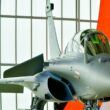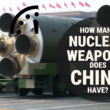Antisatellite warfare without nuclear risk: A mirage
By Nancy Gallagher, May 29, 2015
The 1967 Outer Space Treaty banned weapons of mass destruction in orbit, but it also established that space would be free for all states to use in accordance with international law (including the UN Charter). The Cold War superpowers interpreted the treaty as legitimating and protecting the use of satellites for early warning, crisis communication, verification, and other activities contributing to deterrence stability—but not for aggression.
In recent decades, however, as space-based reconnaissance, communication, and targeting capabilities have become integral elements of modern military operations, strategists and policy makers have explored whether carrying out antisatellite attacks could confer major military advantages without increasing the risk of nuclear war. In theory, the answer might be yes. In practice, it is almost certainly no.
Hyping threats. No country has ever deliberately and destructively attacked a satellite belonging to another country (though nations have sometimes interfered with satellites' radio transmissions). But the United States, Russia, and China have all tested advanced kinetic antisatellite weapons, and the United States has demonstrated that it can modify a missile-defense interceptor for use in antisatellite mode. Any nation that can launch nuclear weapons on medium-range ballistic missiles has the latent capability to attack satellites in low Earth orbit.
Because the United States depends heavily on space for its terrestrial military superiority, some US strategists have predicted that potential adversaries will try to neutralize US advantages by attacking satellites. They have also recommended that the US military do everything it can to protect its own space assets while maintaining a capability to disable or destroy satellites that adversaries use for intelligence, communication, navigation, or targeting. Analysis of this sort often exaggerates both potential adversaries’ ability to destroy US space assets and the military advantages that either side would gain from antisatellite attacks. Nonetheless, some observers are once again advancing worst-case scenarios to support arguments for offensive counterspace capabilities. In some other countries, interest in space warfare may be increasing because of these arguments.
If any nation, for whatever reason, launched an attack on a second nation's satellites, nuclear retaliation against terrestrial targets would be an irrational response. But powerful countries do sometimes respond irrationally when attacked. Moreover, disproportionate retaliation following a deliberate antisatellite attack is not the only way in which antisatellite weapons could contribute to nuclear war. It is not even the likeliest way. As was clearly understood by the countries that negotiated the Outer Space Treaty, crisis management would become more difficult, and the risk of inadvertent deterrence failure would increase, if satellites used for reconnaissance and communication were disabled or destroyed.
But even if the norm against attacking another country’s satellites is never broken, developing and testing antisatellite weapons still increase the risk of nuclear war. If, for instance, US military leaders became seriously concerned that China or Russia were preparing an antisatellite attack, pressure could build for a pre-emptive attack against Chinese or Russian strategic forces. Should a satellite be struck by a piece of space debris during a crisis or a low-level terrestrial conflict, leaders might mistakenly assume that a space war had begun and retaliate before they knew what had actually happened. Such scenarios may seem improbable, but they are no more implausible than the scenarios that are used to justify the development and use of antisatellite weapons.
Reducing danger. One way to moderate the nuclear risks associated with antisatellite weapons is to realistically assess arguments that attacking satellites would be an easy way to achieve major military advantages without creating unanticipated or uncontrollable consequences. For example, unclassified analysis by Jaganath Sankaran, a research scholar at the Center for International and Security Studies at Maryland, suggests that the practical limitations of Chinese ballistic missiles and launch facilities would make it much harder for China to attack critical US satellites during a crisis than it would be for Washington to respond in ways that denied Beijing any military advantage from such an attack. As more such studies are conducted and given serious consideration, policy makers will be less likely to invest heavily in antisatellite capabilities or to take pre-emptive action against purported antisatellite threats.
Another important way to reduce risk is to strengthen both the norms and the legal rules that protect satellites. The most straightforward way to accomplish this would be to prohibit using anything, including other space objects, to damage or destroy satellites that are not themselves being used as space weapons; and to prohibit any testing of methods for damaging or destroying such satellites. Currently, the biggest threat to established norms and legal protections comes from people who cite anticipatory self-defense—during a crisis or at the outset of hostilities—as a justification for disabling or destroying satellites, launch facilities, or ground stations. Almost as dangerous are those who argue that, once war begins, anything in space becomes fair game and therefore should be targeted. Although it might be legal in the midst of a war to attack satellites used for command, control, communications, and intelligence, it doesn't follow that attacking satellites would be smart strategy.
Voluntary measures for transparency and confidence-building could also help reduce risk somewhat. For example, improving the space situational awareness of all space actors would lessen the risk that nations will blame the wrong party for damage to their satellites or mistakenly conclude that their satellites have been attacked when they have malfunctioned for other reasons. Only a few major spacefaring powers have capabilities for space object detection, tracking, and cataloging—that is, identifying a space object as either debris or a satellite, and also identifying a satellite's owner and function. These nations' capabilities are widely asymmetrical. Only the United States, which has the most sophisticated capabilities, shares space situational data with other space actors. But it does so in a limited manner. Today's lack of transparency regarding space operations exacerbates mistrust among spacefaring nations. More extensive and more inclusive arrangements for data sharing could help reduce mistrust.
But nuclear risks associated with the increased military use of space can only be significantly reduced through transparency and confidence-building measures if the countries that promote such measures prioritize credible reassurance as much as they emphasize deterrence and defense when they decide how much space-related information to share, or what capabilities to acquire and how to use them. Such nations also must rethink the aspects of their nuclear postures that increase the overall risk of inadvertent deterrence failure. In the end, if all nuclear-armed nations espoused unequivocal no-first-use policies, and maintained very tight managerial control over small arsenals optimized for retaliatory deterrence, it would be much harder to envision the proliferation of antisatellite capabilities leading to a nuclear war that nobody wanted.
Topics: Nuclear Weapons, Technology and Security
Share: [addthis tool="addthis_inline_share_toolbox"]














